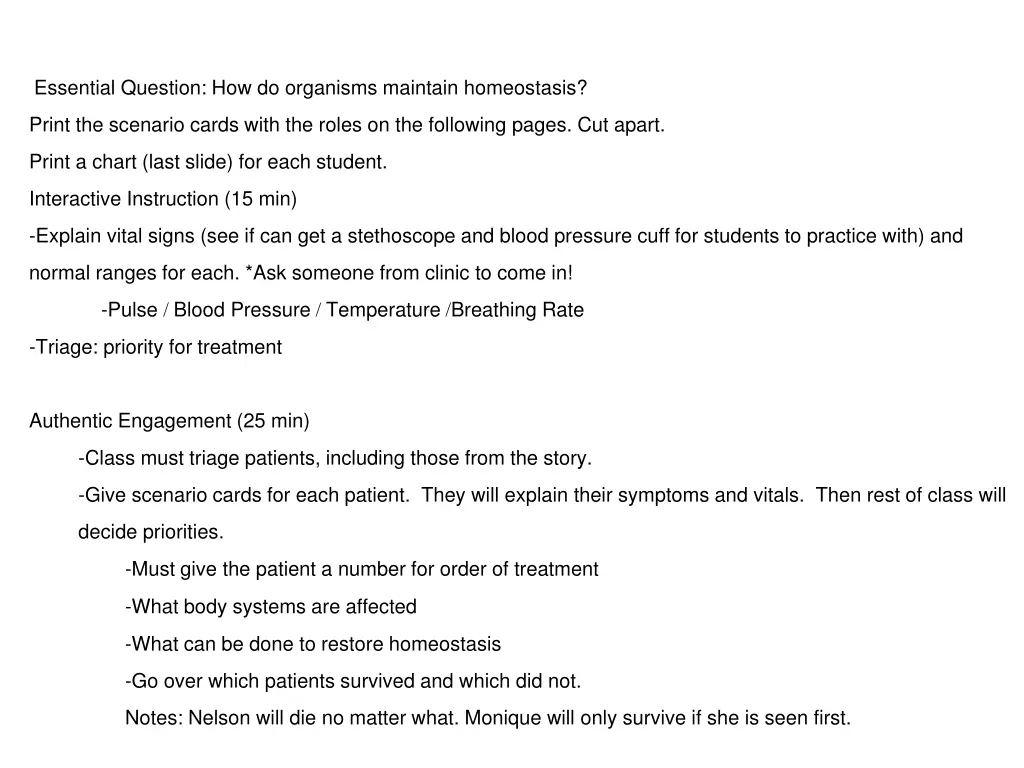
Organisms' Homeostasis Maintenance through Vital Signs Triage Activity
Engage students in an interactive lesson on how organisms maintain homeostasis by analyzing vital signs and triaging patients based on severity. Explore scenarios involving various health issues to enhance understanding of the body's response mechanisms.
Uploaded on | 3 Views
Download Presentation

Please find below an Image/Link to download the presentation.
The content on the website is provided AS IS for your information and personal use only. It may not be sold, licensed, or shared on other websites without obtaining consent from the author. If you encounter any issues during the download, it is possible that the publisher has removed the file from their server.
You are allowed to download the files provided on this website for personal or commercial use, subject to the condition that they are used lawfully. All files are the property of their respective owners.
The content on the website is provided AS IS for your information and personal use only. It may not be sold, licensed, or shared on other websites without obtaining consent from the author.
E N D
Presentation Transcript
Essential Question: How do organisms maintain homeostasis? Print the scenario cards with the roles on the following pages. Cut apart. Print a chart (last slide) for each student. Interactive Instruction (15 min) -Explain vital signs (see if can get a stethoscope and blood pressure cuff for students to practice with) and normal ranges for each. *Ask someone from clinic to come in! -Pulse / Blood Pressure / Temperature /Breathing Rate -Triage: priority for treatment Authentic Engagement (25 min) -Class must triage patients, including those from the story. -Give scenario cards for each patient. They will explain their symptoms and vitals. Then rest of class will decide priorities. -Must give the patient a number for order of treatment -What body systems are affected -What can be done to restore homeostasis -Go over which patients survived and which did not. Notes: Nelson will die no matter what. Monique will only survive if she is seen first.
Albert Mark Adult male, approximately 25 years old, with a 19-year-old male with a gunshot wound to the chest. possible head injury from a motorcycle accident. Victim is conscious, bleeding moderately, and having Victim not wearing helmet. He is conscious, but has great difficulty breathing. no feeling in his arms, legs, or torso. Heart Rate: 150 beat/min, weak Heart Rate: 100-105 beat/min Temperature: 98.6 degrees Temperature: 98.6 degrees Blood Pressure: 100/60mmHg Blood Pressure: 80/50mmHg Breathing Rate: 23 resp./min Breathing Rate: 20-22 resp./min
Ed Maria 15-year-old girl with symptoms of severe diarrhea 41-year-old male, obviously over- weight, called and vomiting paramedics complaining of crushing chest pains. He is now unconscious. Heart Rate: 115 beat/min Heart Rate: 110 beat/min, weak Temperature: 104 degrees Temperature: 98.6 degrees Blood Pressure: 110/70mmHg Blood Pressure: variable Breathing Rate: 21 resp./min Breathing Rate: 12 resp./min
Esther Nelson 85-year-old female complaining of dizziness. Has a history 51-year-old man rescued from the canyon. of heart problems and suffered a moderate stroke (blood He was unconscious and having seizures vessel in brain ruptured) 6 years ago, resulting in mild left- when brought into the emergency ward. side paralysis. Heart Rate: 45 beat/min Heart Rate: 105 beat/min, weak Temperature: 109.4 degrees Temperature: 96.8 degrees Blood Pressure: 85/50mmHg Blood Pressure: 160/65mmHg Breathing Rate: 10 resp./min Breathing Rate: 22 resp./min, labored
Monique 18-year-old woman rescued from the canyon; stung by bee. She is dizzy, nauseous, has cracked lips, is having difficulty breathing, and has a rash on her legs and stomach. Heart Rate: 120 beat/min Temperature: 105.8 degrees Blood Pressure: 87/50mmHg Breathing Rate: 30 resp./min, labored breathing
Patient Name Brief Description Heart Rate Is Temperature Blood Pressure Breathing Rate Which body Priority Number & systems are Reasoning What is wrong with Is it within normal Is it within normal Is it within normal it within normal the patient? limits? limits? limits? affected? limits?
